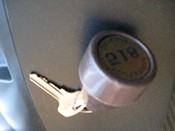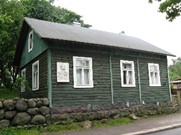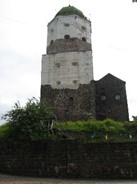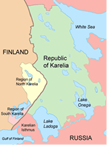Archive for the ‘Finland’ Category
A Wartime Visit to Russia
Russia commands the news headlines these days. Yet again, they invade Ukraine, as they did when they seized Crimea in 2014. Because of the unrest at that time, We were apprehensive about making a genealogical visit to Russia that spring.
Knowing that the country had mobilized, we wondered whether it would be safe for Americans to visit Vyborg, a city northwest of St. Petersburg on the Gulf of Finland. I wanted to see the place my Finnish ancestors had lived in the early 20th century when Vyborg was part of Russia’s Duchy of Finland. At the time, the city was called by its Finnish name, Viipuri. Today, only ethnic Russians live there. The Finns left after being compelled to transfer ownership to Russia after WWII.
My great-grandfather’s Finnish family lived in the Vyborg area and worked at various occupations, including undertakers and carpenters. My great-grandparents Ada Alina Lampinen and Alexander Mattila were married in Viipuri in 1904. They emigrated to the United States in 1905.
As I eyed the news reports in 2014, my genealogical curiosity to see the place won out. Ukraine seemed far away, so we decided to make the stop in Vyborg during a longer trip through Finland. We learned we did not even need a visa to enter Russia provided we gave advance notice, arrived by water, and stayed in Russia no longer than three days.
Finland leases from Russia the Saimaa Canal (which the Finns had built in 1845) connecting their city Lappeenranta with Vyborg. They conduct regular boat trips between the cities.
We booked our passage and exchanged some American dollars for Russian rubles.
On the embarkation day, we left most of our belongings, particularly our electronic devices, behind in Finland. We packed a backpack with only what we needed overnight and hopped on the canal boat.
These 5-hour canal boat rides to and from Vyborg were some of the most delightful excursions we have ever taken. The scenery was beautiful, and the Finns were fun-loving travel companions.
An accordion player provided entertainment, and everyone sang along. Finnish is a phonetic language, and with a song sheet it was easy to chime in.
When we arrived in Vyborg, we lined up to present our passports. Everyone ahead of us was casually waived through. When my husband/tech advisor handed his American passport to the border control agent, her head snapped up, and she gave him a long look. Then she stamped it and sent him on his way. I was next, and I, too, stepped into Russia.
Vyborg seemed like a step back in time. The vibe of the city seemed unchanged from the days when Finland owned it in the 1940’s.
Our hotel, purportedly the nicest one in town, was a throwback to another era. We received one room key on a large fob.  The tiny elevator could accommodate only one person at a time, so we took the stairs to our room. There we found bedding neatly stacked on the twin beds. Guests were expected to make their own.
The tiny elevator could accommodate only one person at a time, so we took the stairs to our room. There we found bedding neatly stacked on the twin beds. Guests were expected to make their own.
When we presented ourselves for dinner at the hotel dining room, no one came to seat us. Our tour director noticed our plight and explained that the staff was frightened to serve us. He soothed them, and they agreed we could eat there.
Rather than seating us in the common dining room, they opened an opulent special room just for us and proceeded to serve us a magnificent multi-course meal. We  wondered if they thought this is how Americans are accustomed to eating. When we paid our bill, the total came to the equivalent of $35.00.
wondered if they thought this is how Americans are accustomed to eating. When we paid our bill, the total came to the equivalent of $35.00.
They next day, we were free to roam the city provided we did not leave the city limits. Vyborg is a walkable city, beautifully laid out long ago by the Finns, so we stayed on foot. We looked for the neighborhood where my great-grandparents had lived. Nearby, we found the revolutionary Vladimir Lenin’s house marked with a commemorative plaque.
A highlight of our walking tour was Vyborg Castle. This medieval fortress was built by the Swedes in 1293. We bought tickets to go inside and climbed the rickety stairs to the top. We could barely see the harbor through the dirty windows.
Back on the ground, my husband/tech advisor was sorely in need of a rest room. We had no idea how to read the Cyrillic directional signs. He could not seem to get the staff to understand his request. Finally, he resorted to the potty dance that all parents recognize. Broad smiles broke out as they understood what he needed. They graciously showed us the way to a primitive bathroom.
Late that afternoon, as we awaited the arrival of the canal boat for our return trip, we stopped in our hotel bar for a shot of superb Russian vodka. Then we boarded the boat without incident.
During this trip into Russia, we had interactions with only a few people. Although they seemed reserved and suspicious of us, they helped us when they understood what we needed. No one bothered us during our walk around the city. They were happy to sell us merchandise at the market and tickets at the castle. With an intervention from a trilingual Finn, we had a fine evening meal at the hotel.
We felt like we had a glimpse of the real Russian population during this trip. They were conducting their businesses and going about their everyday lives, just as we do. We imagine we were watched while we were there, but it was not obvious if we were.
These people did not seem like warmongers. It is heartbreaking today to see these same people feeling compelled to invade their neighbors.
The Crimean takeover back in 2014 was non-violent. We felt we could take the risk to enter Russia for a brief visit. We would not make the same decision in 2022.
Fading Christmas Traditions
 The Nordic immigrants in my family arrived in America in the early 20th century. They brought with them their way of celebrating Christmas.
The Nordic immigrants in my family arrived in America in the early 20th century. They brought with them their way of celebrating Christmas.
In this tradition, families gathered on Christmas Eve to share holiday food and exchange gifts. Santa Claus (Julenisse in Norway and Joulupukki in Finland) would knock on the door to leave a special gift for each child in the household.
The next morning, on Christmas Day, these devout people attended their Lutheran church to mark the Savior’s birth.
I have always loved celebrating the Christmas holiday this way, but it is becoming harder as the years go by. The Scandinavians have assimilated into the American way of life, and their former practices have given way to the dominant culture.
Yet even as most people seem to have switched to opening Christmas gifts in the morning on the 25th, I would rather attend church then. This presents a problem for me because most Lutheran churches no longer hold a service on Christmas Day. On the day before Christmas, they bend over backwards to have services all day and evening, and then tell you to stay home on Christ’s birthday.
This year my own congregation has decided to follow the new pattern and skip a Christmas Day service. I asked the church office to point me to another congregation in the area that still schedules a December 25 worship service. They could not.
After some internet searching, I finally found one. Only one. You can bet I will be in the pew there on Christmas morning, even as this tradition fades away all around me.
Thanksgiving Stories
 During these months of the Covid-19 virus, holiday celebrations differ from those in times gone by. As my husband/tech advisor and I enjoyed our Thanksgiving dinner at home this year, I thought about my grandmothers’ Thanksgiving stories. Their holidays were not as I would have expected.
During these months of the Covid-19 virus, holiday celebrations differ from those in times gone by. As my husband/tech advisor and I enjoyed our Thanksgiving dinner at home this year, I thought about my grandmothers’ Thanksgiving stories. Their holidays were not as I would have expected.
Grace Riddle Reed (1896-1976)
My Dad’s mom descended from the Pilgrims. You would think Thanksgiving would be a big day for her. Yet she never spoke of preparing a Thanksgiving dinner. Nor did my dad remember celebrating the holiday in his childhood home. Perhaps they never did.
Grandma Grace grew up on a poor homestead in the Nebraska Sandhills. She raised her own kids as a widow during the Great Depression. Money was hard to come by, perhaps not to be spent on a lavish dinner.
Even if she could scrape together the necessary funds, she may not have bothered to put together a Thanksgiving meal. Grandma never cooked, leaving the task instead to Dad’s older brother Owen. His signature dishes were rhubarb and oatmeal, probably all they had available. Once he left home, Dad never ate either of those things again.
Under these circumstances, I believe Dad never had a traditional Thanksgiving dinner until he married my mom. Odd for a man with his ancestry.
And what about Grandma? I asked her one Christmas what she had eaten for Thanksgiving dinner that year. She vaguely replied, “Oh, some canned chicken noodle soup.”
Martha Mattila Bentsen (1906-1977)
My mom’s mother was the child of Finnish immigrants. They made every effort to leave their Finnish culture behind and to become as Americanized as they could.
They wholeheartedly embraced the Thanksgiving tradition as soon as they learned about it. The family held large Thanksgiving family gatherings. They learned to roast a turkey with all the trimmings.
Of course, these meals had a Finnish twist. There were several types of pickles—cucumbers and beets. There was a rutabaga casserole. There was Finnish bread.
After her parents died, Grandma Martha continued to host Thanksgiving dinners for family members. We joined her several times during my childhood. I always enjoyed these Finn-style Thanksgiving dinners, never knowing there was anything unusual about them.
As I look back, I realize that I developed my idea of a proper Thanksgiving celebration and meal from my experience with the holiday as celebrated by Finnish immigrants. My American ancestors contributed nothing to my understanding of the holiday because they did not participate in it.
You would think it would be the other way around. But in my family, the 11th-generation Americans did not celebrate Thanksgiving while the recent immigrants did.
Joulupukki
 When I was a girl, Santa delivered each of us kids a special gift on Christmas Eve. He would ring the front doorbell and leave it on the porch shortly after we finished our traditional Christmas Eve meal of ham and potato salad.
When I was a girl, Santa delivered each of us kids a special gift on Christmas Eve. He would ring the front doorbell and leave it on the porch shortly after we finished our traditional Christmas Eve meal of ham and potato salad.
I thought everyone celebrated the holy night this way. Only after I grew up did I learn that we probably followed an Americanized version of a Finnish Christmas tradition that my mom had learned from her immigrant grandparents.
The Finnish Santa is called Joulupukki. He dresses not in red velvet but in fur. He bears gifts to children in Finnish homes on Christmas Eve. Instead of sliding down a chimney after they go to bed, he knocks on doors during waking hours and asks whether any good children dwell there. All the well-behaved youngsters receive a gift from him. In appreciation, they sing carols.
Usually, we in our American household did not see Santa/Joulupukki in person on Christmas Eve. My mom explained that he was in too much of a rush to wait for us to answer the door. He simply dropped off our gifts and hurried on.
This year, I was re-introduced to Joulupukki when he attended our local Finnish Christmas party. We welcomed him with a traditional song (https://www.youtube.com/watch?v=r7HorrUBmTs). Then he presented gifts to all the good children, but none of my own grandchildren were there. This got me thinking.
I decided to resurrect the idea of Joulupukki in a small way for my family this Christmas. I signed some of my gift tags with “Joulupukki” instead of “Gran and Granddad”. Then I waited to see if anyone would notice.
Our eldest granddaughter, a 16-year-old, asked about the unfamiliar tag. That question gave me an opening to explain about Joulupukki and to share a bit of my (their!) Finnish heritage.
I tried, but the grandchildren did not seem very interested in this tradition when so much other gift-giving went on around them. Even so, they have now heard the story. They may remember it if I decide to have Joulupukki make another visit next year.
These children, just 6.25% Finnish, know so little of the traditions their family brought from the old country. Much was lost in my grandparent’s determination to become American. Perhaps I can use the story of Joulupukki to reclaim some of what we have forgotten and pass it along.
Cleaning Out the Old; Getting Ready for the New
 This week my husband/tech advisor and I finished up my 2019 genealogy project. I needed his assistance in creating and printing a large chart. After some trial and error, we at last have it ready to mail out to relatives.
This week my husband/tech advisor and I finished up my 2019 genealogy project. I needed his assistance in creating and printing a large chart. After some trial and error, we at last have it ready to mail out to relatives.
Now I have turned my attention to cleaning up my office and getting everything ready for a new research project in 2020. I have accomplished a few tasks so far:
- At the beginning of the year, I think I had five surnames in my Finnish notebook. After trading information with Finnish cousins, I have identified twenty-eight surnames in the direct line ascending eight generations from my great-grandmother, Ada Alina Lampinen (1879-1948). In addition to putting all this data into digital form in my genealogy database, I have recorded it on family group sheets stored in a three-ring binder. All this new information required me to move my Finnish material to a bigger notebook.
- I am a piler, and I had research-related papers all over the office. I tackled the credenza first, and now I can see its surface again.
- For next year, I have learned that I will need to adjust to a new meeting place for our local Highlands Ranch Genealogical Society. For years we met at the Highlands Ranch library. This year, after a remodeling, the library changed its room reservation policy. No longer could we be guaranteed the same meeting room, or even any meeting room, on our usual meeting night. We tried moving between libraries, taking what was available, but that proved unworkable. Our attendance suffered. Luckily, our kindly Family History Center in Highlands Ranch has stepped forward and offered us a reserved space for our monthly meetings in 2020.
With three weeks left in December, I hope to complete the cleanup of my office before the end of the year. Papers lie in high, deep stacks on both the desk and the worktable. It would be nice to have it all sorted and filed away. I think I have time. On January 1, I want to turn my attention to searching for Mayflower ancestors.
Holiday-Time Genealogy
 The November-December holiday season gets so hectic that normally I take a break from genealogical research during that time.
The November-December holiday season gets so hectic that normally I take a break from genealogical research during that time.
I use November to create a genealogy-related Christmas present for family members. Finnish research dominated my year, and this year’s gift will reflect that.
A distant cousin I met in Finland in June has posted 10 generations of our shared Lampinen line on the WikiTree website. I added all this information to my own online tree. Now my husband/tech advisor has helped me create a beautiful chart displaying this heritage. I will proofread it later today, and then we will print out this 3-foot-wide family tree for the American descendants of Ada Alina Lampinen.
Another Finnish cousin sent me some photos of Ada’s siblings who stayed in Finland. I will get copies made of these pictures for the relatives, too.
December will find me cleaning out my office whenever I have some time to spare. I need to put away the Finnish research materials, documents, and reference books that lie scattered around. Once I have the surfaces cleaned off, the place needs a good dusting. Maybe I can even get back to using my adjustable standing desk when all the precarious clutter returns to its proper home.
Already I am thinking about next year’s project. In 2020 we will celebrate the 400th anniversary of the arrival of the Mayflower. I am hoping to confirm a suspected Mayflower line in my own family. One of my grandmothers had New England ancestors with surnames like Bangs, Burgess, Dunbar, Hall, and Snow. Her second great-grandmother, Lucy Snow, may have been a Mayflower descendant.
For Christmas a year ago, my husband/tech advisor gave me a membership in the New England Historic Genealogical Society. These folks specialize in everything related to the Mayflower and other New England ancestry. All year I eagerly have read their publications. In 2020 I finally will begin doing some research using all the resources they have to offer.
Holiday time = time to clean up and switch gears.
Petter Toivain: Sexman
 Sexman? What might that be?
Sexman? What might that be?
I encountered this interesting profession as I powered through the Lampinen family tree shared by my Finnish cousins. A Toivain father-son pair of ancestors, both named Petter, worked as sexmen in the 17th century. Who employed them, and what did they do?
The word Sexman seemed more a Swedish word than Finnish one to me. When the Toivains lived and worked, Finland was part of Sweden. Many records during that time were kept in the Swedish language.
I plugged the word into Google Translate and searched for an English meaning from either Swedish or Finnish. No result. A sexman was a sexman in all three languages.
Next I turned to the Family Search wiki (https://www.familysearch.org/wiki/en/Swedish_Genealogical_Word_List). They have word lists of genealogical terms, including occupations, for many languages. I tried the Swedish list first, and there I found it.
A sexman was the parish caretaker. My Finnish cousin then explained that the sexman’s obligations included seeing that the congregation members performed their religious duties, obeyed the Commandments, paid their tithes, and paid fines for any ecclesiastical offenses. The sexman also monitored parishioners for infectious diseases and transported ill members to the hospital. He held a key to the ark.
This must have been an important and powerful job in the state-mandated Lutheran Church of the time. Where did my ancestors serve?
The Toivain family lived in the tiny village of Kajoo, part of Juuka parish in Finnish Karelia. The present-day Juuka church is pictured above.
From the record, I cannot determine whether my ancestors had authority over the entire Juuka parish, or just Kajoo and its environs. My Finnish cousins have no more information to offer.
They did provide statistical information on the the Toivains who served as sexman:
- Petter Toivain, b. 18 Feb 1747 at Kajoo, d. 21 Apr 1809 at Kajoo. Married Anna Frantz 14 May 1765 at Nurmes.
- Petter Pettersson Toivain, b.21 Jun 1771 at Kajoo, d. 26 Jun 1818 at Kajoo. Married Anna Karjalainen, 25 May 1795, at Kajoo.
Closing Out Another Year
 Each year I spend ten months on genealogical research. I choose an ancestor as my annual project. Then I learn everything I can about him or her. At year’s end, I assemble the information and mail it around to relatives.
Each year I spend ten months on genealogical research. I choose an ancestor as my annual project. Then I learn everything I can about him or her. At year’s end, I assemble the information and mail it around to relatives.
I began with more recent ancestors and worked backwards over the years. I have completed character sketches and photo collections for seven of my great-grandparents and their parents. This year I turned to the generation of my 3rd great-grandparents.
I spent most of this year working on Finnish lines, those ancestors of my 2nd great-grandparents Matti Lampinen (1835-1894) and Anna Miettinen (1832-?). Recently-discovered cousins in Finland who also descend from this couple have posted this family tree on the WikiTree website. Now I have most of it in my database, too.
Over the next couple of weeks, I will complete the data entry. The information consists of only the usual names, dates, and places. The family stories we all want to learn have not been preserved on WikiTree, and my family did not save them.
Finnish records available to me can shed no additional light on the lives of these ancestors. I have only church records to look at—birth/marriage/death lists and communion books that list family groups.
I cannot write any interesting character sketches from these basic facts. I will not send around a family story this year.
In its place I can create a massive family tree poster that reaches back into the late 17th century. I can also reproduce photos of family members who remained in Finland when my great-grandmother Ada Alina Lampinen (1879-1948) emigrated to America.
When the calendar turns to November, I will begin creating this year’s family history gift. It will go out with my Christmas cards in December.
Leaving the Lampinens for Now
 One of my goals as a genealogist is to put my family tree out there to record it for posterity and to make it available to cousins seeking to find their roots. For several weeks I have worked on posting Finnish ancestors to my website.
One of my goals as a genealogist is to put my family tree out there to record it for posterity and to make it available to cousins seeking to find their roots. For several weeks I have worked on posting Finnish ancestors to my website.
A third cousin in Finland has done a tremendous amount of research on our common Lampinen line. We both descend from Matti Henricsson Lampinen (1835-1894) and Anna Miettinen (1832-abt. 1910). My cousin descends from the couple’s daughter Hendrika (1862-1928), and I descend from their daughter Ada Alina (1879-1948). Ada was my great-grandmother.
I have now added Matti Lampinen’s ancestors, as far as we know them, to my online family tree. Some lines extend back to the 1650’s. You can view them on my website (www.norsky.net under the Reed/Bentsen link), or you can look at my cousin’s Lampinen tree on WikiTree (www.wikitree.com).
Next I will turn to the Miettinen ancestors and get them posted.
Following this family’s trail fulfills a lifelong ambition for me. Years ago, when I began my genealogical research in earnest, I started with the Finns. I was so curious about them. Yet I gave up after documenting my Finnish-American ancestors. Doing foreign research was beyond my capability and resources at the time.
Now, with online records and connections to Finnish cousins, the project has become doable for me. I am loving the process of getting to know this family and sharing it with everyone.
Finnish Forbears Discovered
 I have a lot of Lampinen relatives, a family I learned about only a year ago. Last fall, a missing person locator hired by a distant cousin in Finland put me in touch with descendants of Hendrika Lampinen Andelin (1862-1928), an older sister of my great grandmother, Ada Alina Lampinen (1879-1948). I visited two of these cousins when I was in Helsinki in June.
I have a lot of Lampinen relatives, a family I learned about only a year ago. Last fall, a missing person locator hired by a distant cousin in Finland put me in touch with descendants of Hendrika Lampinen Andelin (1862-1928), an older sister of my great grandmother, Ada Alina Lampinen (1879-1948). I visited two of these cousins when I was in Helsinki in June.
Our shared Lampinen surname in Finnish has to do with living near a pond. The Lampinens lived around a large body of water, Lake Pielinen, the eastern Finland area known as Karelia.
My great-grandmother left there in 1905 to come to America as a young bride. Although she had several older siblings, none of them emigrated to the United States. Ada’s daughter, who was my grandmother, always said she knew nothing of her Lampinen family. The Finnish and American branches of the family lost touch with one another when the older generation died.
One of my new-found cousins has posted a large Lampinen family tree on the WikiTree website (wikitree.com). She has done a tremendous amount of research. The tree extends 6 generations back from my ancestor Ada. The earliest ones lived during the mid-1700’s.
Because of my Finnish cousin’s work, an ancestry tree for 12.5% of my heritage has fallen into my lap. This researcher has ready access to many sources I do not have, and she has posted all of those citations on the WikiTree website.
I have spent many days this summer combing through her work to learn about our common Lampinen forebears. As far back as records extend, they lived in villages surrounding Lake Pielinen.
All must have been Finnish with no intermarriages to Swedes, Lapps, or Russians. My DNA test comes up 26% Finnish, a heritage I received from Ada and my Finnish great-grandfather Alexander Mattila (1878-1945).
It would have taken me a lifetime of research to build the Lampinen family tree found on WikiTree. Now, thanks to this cousin, I need not do it. I trust that this native Finn has been accurate and thorough in compiling our shared tree. It has been great fun to study it.
Finally, I have learned the names of those who comprise such a significant portion of my heritage. Not only do I have Lampinen ancestors, but I also have the names of women who married Lampinen men. The tree includes Heinonens, Horttanianens, Kärkäinens, Louhelains, Miettinens, Parkkinens, Ruottins, Turuins, and many more. My cousins and I carry genes from all of them, and now we know who they are.